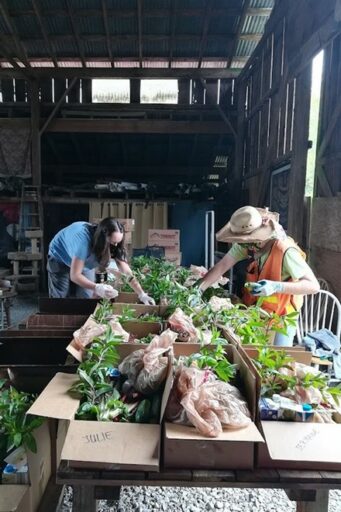- Agriculture & Food Defense, Articles, Communication & Interoperability, Critical Infrastructure, Emergency Management, Emergency Medical Services, Fire, Hazmat, Hospitals, Public Health, Science & Technology, Transportation, Volunteerism
- by: Zsofia Pasztor & Szabolcs Pasztor
When the pandemic emerged in Washington State, the region’s already strained food assistance programs became overwhelmed. Since 2011, the agricultural nonprofit organization Farmer Frog had already been servicing about 25,000 families in the Greater Seattle Area through its Good Food Treasure Box program – a subsidized Community Supported Agriculture (CSA) food box program that quickly expanded to support the area’s needs. Volunteers packed the boxes as Farmer Frog distributed increasing volumes of food (see Figure 1). The program grew to a nationwide hunger relief distribution operation. With its partner nonprofit, the National Tribal Emergency Management Council (NTEMC), the program has distributed more than 160 million lbs of food and emergency supplies to over three million people in 36 states since 2020 (as recorded through inventory tracking software).

Fig. 1. Farmer Frog volunteers pack boxes of food in Washington in March 2020.
Response to Pandemic, Fire & Ice
Farmer Frog primarily provides services at its outdoor distribution, logistics, and innovation center known as the FLOOR (Food Logistics Operations Offices and Resources). Designated as an official incident command center under Washington Emergency Management Division Mission No. 20-0265, the FLOOR became a pilot hunger relief hub connecting small and large entities across various sectors. After partnering with NTEMC, Farmer Frog increased its distribution rapidly. For example, its regional 35-million-lb food distribution efforts expanded to 160 million lbs nationwide to help feed communities during two years of COVID-19 (2020-2021). Also, in 2021, NTEMC and Farmer Frog shipped half a million pounds of food and personal protective equipment (PPE) to Tribes and Native Villages in Alaska via maritime transport. During the 2021 response efforts, delivery timing was critical – especially after a local water tower burned down, leaving thousands without water, as Native Tribes and Villages continued to face food, PPE, and other resource shortages.
In emergency response, it is difficult to capture on paper the challenges and experiences faced amid overwhelming amounts of daily pressures. Many Americans do not know where food comes from or how it is transported. For example, the 2021 Alaska relief effort involved moving half a million pounds of food and supplies via a giant barge. A typical load for TOTE Maritime, the generous donor of the barge transportation, is a single container per client – that relief effort required ten! And while most people use refrigeration to keep things cold, the water in that scenario had to be refrigerated to keep it warm enough to prevent it from freezing in the frigid Alaskan temperatures (see Figure 2).

Each experience can better prepare communities for the next crisis and build resources and support networks to respond appropriately – no matter the scale of the event. In Washington State and at the direction of NTEMC, Farmer Frog coordinates distribution via planes in partnership with the Disaster Airlift Response Team (DART) to Tribes in remote locations and delivers a variety of procured, donated, and rescued goods with direct transport – via land, air, and sea to provide full accessibility. Rescued goods are products from farmers and producers that are intercepted before being wasted. For example, during the early days of COVID-19 when restaurants were not selling French fries, some farmers with entire warehouses of potatoes chose to offer their produce to Farmer Frog and other distributors for free or at heavily discounted costs rather than tilling the potatoes into the ground for a complete loss. To provide true hunger relief, the organization must send resources where needed, connect with recipients on a personal level (whether a government agency or community-based organization), and ensure they meet the community’s needs. The goal is to create an infrastructure that eliminates inefficiencies in the system and provides full-service distribution to increase access to equitable services, especially during an emergency.
Engagement in Earthquake Exercise
After servicing more than 600 different recipient agencies and more than 120 Tribes across 36 states, Farmer Frog and NTEMC used their networking capabilities and team spirit to participate in the full-scale multidiscipline Thunderbird and Whale exercise, practicing the response for a future 9.0-magnitude Cascadia Subduction Zone earthquake. With NTEMC as the exercise’s incident command, Farmer Frog provided three main logistics and distribution functions:
- Supported the airlift of food out of Walla Walla, Washington;
- Facilitated and participated in a mass casualty incident exercise; and
- Transported ground deliveries of needed food and supplies while observing (and reporting on) damaged roads, bridges, and communication system challenges as the exercise prescribed.
They also provided labor and supplies in the setup and teardown of the incident command center. Although primarily operating within Emergency Support Function #11 (ESF#11 – Agriculture and Natural Resources), Farmer Frog also provided minor support under ESF#6 (Mass Care, Emergency Assistance, Housing, and Human Services) and ESF#8 (Public Health and Medical Services). These are areas where the organization has gained experience through services provided since 2009, scaled up when COVID-19 emerged in the U.S. in 2020 and implemented during other real-life emergencies.
As a regional team across several states, the 9.0-earthquake simulation demonstrated the challenges that many Tribes of the Pacific Northwest would face in that scenario. However, the lessons learned could also apply to other emergency scenarios affecting these same food distribution routes. This exercise reinforced previous observations that the desire for perfect preparation can slow down or stall a response. Under dire circumstances – such as an earthquake, a hurricane, or another major disaster – when people are hungry, they may not be able to wait till tomorrow for food and water.
During the exercise planning process, Farmer Frog participants had expectations typical of an earthquake – communication lines disrupted, roadways destroyed or inaccessible, etc. – but they learned a lot more than expected and added many new tools and resources to their preparedness toolbox. To provide another opportunity to simulate the air transport of food and supplies, DART asked Farmer Frog to coordinate a food donation of 22,000 lbs. That was a small amount relative to the millions they regularly supply to the community, yet still challenging because of weight restrictions on small planes. Nevertheless, it was a valuable experience for all, as many of the volunteer pilots were unfamiliar with the requirements to store food in bulk for an extended amount of time, the labor required for loading and sorting, etc. (see Figure 3).
Simulating the earthquake in the context of agricultural work, the team members practiced “Drop, Cover, and Hold On” at the time of impact during the exercise at their homes or facilities. The simulations also accounted for damaged roadways and rerouting food deliveries with (offline) maps of the region. Collaboration with other participants was fluid and could shift if needed based on what would likely occur during an earthquake. In coordination with Farmer Frog, the United States Volunteer Joint Services Command (USV-JSC) simulated a unique triage training with the volunteers. Together, they created “damaged structures” where one of the main buildings – an old heritage barn built in the late 18th century – collapsed atop team members (see the slideshow). Seasoned personnel of USV-JSC, with years of combat experience, jumped into action to free the victims, address wounds, and then direct transport (with Farmer Frog vehicles) to the incident command center, with simulated emergency airlifts to the hospital.
Under NTEMC’s emergency response leadership, this large-scale exercise activated a multi-state network of agencies and organizations to simulate harsh conditions and events that would likely occur following a 9.0-magnitude earthquake. Strengthening the organization’s capacity and capability, Farmer Frog participants learned valuable lessons to apply to any future crisis:
- Strong leadership makes or breaks a response. In the state of Washington, particularly in food assistance and emergency response, many women have years of experience, wisdom, and unwavering support for those in need. However, during daily and emergency operations, there sometimes are attempts to subvert female leaders in the decision-making process. The result is often wasted time on corrective action and redirection of a response, which can cost lives. Although many agencies and organizations across the country continue to work toward equality and equity, these issues still exist and must be addressed when they arise.
- Be sure to heed expert advice. When urgency drives decisions, expert advice and critical information can be overshadowed during emergencies. For example, the leading agricultural expert for the exercise highly recommended that the potatoes and onions should not be shrink-wrapped together for shipment, as they give off certain gases that are not complimentary to food quality or food storage. This information was disregarded, and the products were transported together. Although the food did not spoil because the temperatures remained low, it was not as crisp and fresh as it would have been if they were transported in separate packaging.
- Time is of the essence in agriculture and disasters. Farmer Frog recommended distributing the food a day or two before the simulated airlift. Still, the DART volunteers wanted deliveries eight days before the flight date to prepare for the airlift. As a result, the whole distribution team organized, packed, itemized, and labeled all the loads for the airlift on an earlier schedule. However, if the weather had not stayed unseasonably cool and misty during the exercise, the food would not have maintained its quality and value for the recipient Tribes and communities by the time the airlift took place.
- Diversity in capability and flexibility to pivot allows for swift and appropriate responses. For example, if roads were blocked or communication interrupted, most communities in the exercise area would be in complete isolation. The only way in or out would be via air or a bulldozer in front of a semi-truck. Communities should evaluate their current capabilities for establishing access to food and critical supplies at the source and ask the following questions:
- What is available within the community?
- Is it safe from the elements?
- Could it be available during a large-scale event or exercise?
- Is there a memorandum of understanding or other agreements with surrounding communities to be hubs outside areas with potentially limited access during an event?
- Disaster preparedness is a whole community effort. Over the past two years, agricultural volunteers at Farmer Frog have had many opportunities to learn various skills to protect themselves and their communities during disasters. Activities included PPE measures and distribution procedures during a pandemic, evacuation vs. shelter-in-place decision-making, an introduction to incident command, post-disaster surveillance for passable routes, exposure to emergency communications, and training on bleeding control and basic triage methods during a mass casualty incident.
In summary, for more than a decade, Farmer Frog has been serving local communities with their growing agricultural and food services. With the strong leadership of the NTEMC and their multidiscipline partners, these critical resources are expanding regionally and nationally to help reach communities in need. From providing food and PPE during the pandemic to participating in the broad multijurisdictional Thunderbird and Whale exercise, Farmer Frog is learning how to better prepare for and respond to emergencies and disasters and build more resilient communities for all people in the Pacific Northwest and beyond.

Farmer Frog is a Washington-based 501(c)3 nonprofit with the mission to grow kids, cultivate communities, and nurture habitat for “All Living Beings through Real Food – Sprouting Simple Change.” Farmer Frog offers statewide and nationwide emergency response hunger relief by partnering with over a thousand entities nationwide, including Tribal governments and Tribal agencies

Zsofia Pasztor
Zsofia Pasztor, executive co-director of Farmer Frog, is a refugee from Hungary during the Soviet times and is one of the founders and executive co-directors of the nonprofit organization Farmer Frog. She teaches restoration horticulture, urban agriculture, aquaponics, and low-impact development at several Puget Sound colleges and abroad. In addition, she trains professionals in sustainable site management, small-scale integrated agriculture, community development, and natural resource conservation. She is a TEDx presenter, an author of professional manuals and the book Rain Gardens for the Pacific Northwest, an award-winning landscape designer, certified Blue Economy consultant, Caring Economy consultant, Low-Impact-Development (LID) designer and construction consultant, professional horticulturist, permaculture designer, Filtrexx designer, commercial urban agriculturist, tree risk assessor, and arborist. With her amazing Farmer Frog Team and sister-partner, Lynda Zambrano, she recently co-founded the Fresh Food Coalition and oversees the distribution of food and supplies nationally to over three million people in need.
-
Zsofia Pasztorhttps://domesticpreparedness.com/author/zsofia-pasztor

Szabolcs (Szabi) Pasztor
Szabolcs (Szabi) Pasztor, director of administration for Farmer Frog, is a first-generation Hungarian American and hard-working millennial dedicating herself to changing the failing systems in America. She has a background in civil engineering, politics, law, advocacy, executive management, food assistance, distribution, and logistics. She is very passionate in her work, especially in preparing her community for what she believes is the greatest challenge humankind has faced – the Climate Crisis. And she also deeply works to recognize, understand, and interface with what she believes is the most significant barrier humanity has faced – institutional systems of trauma and oppression, especially the institution of racism. She fights for what is right and always seeks to understand more about her own privilege as a white transwoman, striving for equity and social justice broadcasted in the principles of her work wherever she goes.
-
Szabolcs (Szabi) Pasztorhttps://domesticpreparedness.com/author/szabolcs-szabi-pasztor






